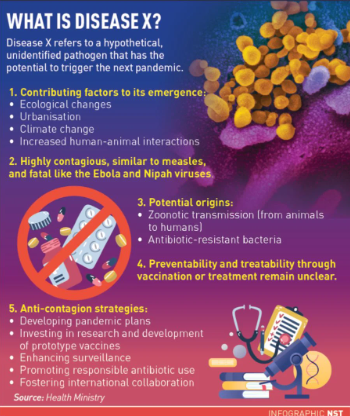By Joke Kujenya
IN A WORLD still reeling from the impact of COVID-19, the concept of Disease X looms large in the minds of public health experts and scientists.
Announced by the World Health Organization (WHO) in 2018, but no many across the world took cognizance, Disease X is said to symbolize a hypothetical pathogen capable of causing a serious international epidemic or pandemic.
And while it may sound like a plot from a science fiction novel, the idea behind Disease X is a critical component of global pandemic preparedness efforts.
Expatiating on this dread, Dr. Amesh Adalja, a senior scholar at the Johns Hopkins Center for Health Security, accentuates the importance of planning for such unknown threats.
“With Disease X, we’re preparing for an unknown unknown,” he explains.

Offering more explanations, he said the placeholder concept of Disease X encourages proactive thinking about potential pandemic pathogens, pushing scientists and public health officials to look beyond known threats like influenza and consider the vast array of viral families that could harbour the next pandemic virus.
He adds that the rationale behind Disease X is clear: the faster the medical world can develop vaccines, treatments, and diagnostic tests in response to an emerging pathogen, the more lives we can save. The COVID-19 pandemic illustrated this vividly, Adalja stresses.
He recalled that BioNTech and Moderna, for instance, were able to rapidly develop their SARS-CoV-2 vaccine candidates thanks to previous work on MERS, another coronavirus.
This head start, Adalja also recalled was crucial in delivering vaccines within months of the COVID-19 pandemic’s emergence, significantly reducing its impact.
A successful pandemic pathogen would likely have certain characteristics.
Dr. Adalja notes further, ” Disease X is likely to be spread through respiration because that’s more efficient for a pathogen given that respiratory transmission, as seen with COVID-19, makes public health interventions challenging.”
Furthermore, the pathogen is expected to be viral rather than bacterial or fungal, and it may spill over from animals into humans or mutate within human populations to acquire pandemic potential.
Disease X emphasizes the need for continuous vigilance and preparedness.
According to Dr. Adalja, pathogens with pandemic potential are not limited to a specific region; they can emerge anywhere.
“While places with high human-animal interaction, such as parts of Asia and Africa, are often considered hotspots, the 2009 H1N1 pandemic originated in Mexico, reminding us that the next pandemic could arise from any part of the world,” Adalja buttresses.
Multi-tiered Approach to Global Preparedness
WHILE the last global pandemic, COVID-19 stormed the world impromptu, Dr. Adalja cautions that this time around, organizations like WHO, the Center for Diseases Control (CDC), Washington DC, the European CDC, and the UK Health Security Agency, who have all been at the forefront, supported by entities like the United Nations and the World Economic Forum, must not slacken off for a second.
He urged that this preparedness must trickle down to state and local health departments, hospitals, and even individual healthcare facilities, including pharmaceutical companies which must also play a crucial role, focusing on vaccine platform technologies that can be quickly adapted in the face of a new pathogen.
Despite advancements, challenges remain, Dr. Adalja stressed, pointing out: “Are we more prepared than we were for COVID? Yes, probably. But are we fully prepared? No.”
Often overlooked issues like hospital capacity, domestic manufacturing of essential supplies, and public acceptance of new technologies persist, he notes.
He cited the response to the recent mpox outbreak as an issue that highlighted significant gaps in testing and treatment availability, showing that even with improved technologies, implementation can falter.
However, there are reasons for optimism, Dr. Adalja encourages.
He said the advent of mRNA and adenovirus vaccine platforms has the potential to revolutionize pandemic response times.
Also, initiatives like the Coalition for Epidemic Preparedness (CEPI)’s 100 Days Mission aim to develop vaccines within three months of identifying a pandemic threat.
Furthermore, programmes like Operation Warp Speed demonstrate how government incentives can mobilize the pharmaceutical industry to act swiftly.
Then, giving a lame man insight into Disease X, Dr. Adalja said, though hypothetical, its nearest future coming serves as a crucial reminder of the unpredictable nature of global health threats.

And this compels us to maintain a state of readiness, ensuring that when the next unknown pathogen emerges, we are equipped to respond rapidly and effectively, stressing that the lessons learned from past pandemics must inform our future strategies, driving a continuous cycle of improvement in our preparedness efforts.
Wrapping up; Dr. Adalja cautions: “In an interconnected world, the emergence of a new pandemic pathogen is not a matter of if, but when. Disease X embodies the unknown, urging us to remain vigilant and prepared for whatever lies ahead. The global health community must continue to invest in research, surveillance, and innovative technologies to protect humanity from the next invisible enemy.”
Eight Diseases That Could Lead to the Next Pandemic
- Another Coronavirus
WHILE the COVID-19 pandemic highlighted the potential of coronaviruses to cause global health crises, Dr. Adalja reveals that other coronaviruses like MERS-CoV and SARS have also caused significant outbreaks, suggesting that future pandemics could stem from this viral family.
- Crimean-Congo Hemorrhagic Fever (CCHF)
The medical expert notes that this is caused by a tick-borne virus CCHF and can spread through contact with infected animal blood or human bodily fluids. CCHF has a high mortality rate and is endemic in parts of Africa, the Balkans, and the Middle East, with potential to spread further due to climate change.
- Paramyxovirus
He discloses that this family includes diseases like measles, mumps, and Nipah virus. Paramyxoviruses are known for their ability to spread through the air and cause severe illness, with Nipah virus being particularly deadly, he said.
- Influenza
It is commonly known that influenza viruses mutate rapidly and can cause pandemics, as seen with the 1918 Spanish flu and the 2009 H1N1 outbreak, Dr. Adalja retraces history, adding that seasonal flu continues to pose a significant health threat, with the potential for a more virulent strain to emerge.
- Rift Valley Fever
This is transmitted by mosquitoes and blood-feeding flies because it is a disease affects both animals and humans and can cause severe illness and death. Its spread could be facilitated by global warming and increased human-animal interactions, Dr. Adalja warns.
- Zika
Known for causing birth defects when contracted during pregnancy, Zika is spread by mosquitoes as it is generally known. Although it typically causes mild symptoms, its potential to cause widespread harm during outbreaks makes it a significant concern.
- Lassa Fever
This is a disease that is endemic in West Africa and transmitted through contact with rodent excreta or human bodily fluids. It causes hemorrhagic fever with a significant fatality rate, particularly in severe cases.
- Disease X
As the culminating endemic pathogen, this term represents an unknown dangerous germ that could cause a future pandemic. This is why the need to serve a reminder of the need for preparedness against unknown viral threats that have not yet been identified but have the potential to emerge, spread rapidly and cause more harm to human and animal lives, this warning is coming ahead.
With information from health agencies
At JKNewsMedia, our dedication to delivering reliable news and insightful information to our cherished readers remains unwavering. Every day, we strive to provide you with top-notch content that informs and enlightens. By donating to JKNewsMedia, you directly contribute to our mission of delivering quality journalism that empowers and informs. Your support fuels our commitment to bringing you the latest updates and in-depth analysis. Let's continue to uphold the highest standards of journalism and serve our community with integrity and dedication. Thank you for being a part of the JKNewsMedia family and for your ongoing support.






The World Health organisation need to do more and prepare against the foreseen hit of the disease.
All states need to take precautions because the death rate of COVID-19 was massive and it’s something that need not be experienced again.
All necessary measures are needed to stand firm against this.
I concur my darling. They should not wait till the problem happens, and then, get confused and won’t know what to do then. We pray the LORD have mercy on all innocent populations of the world, Amen!